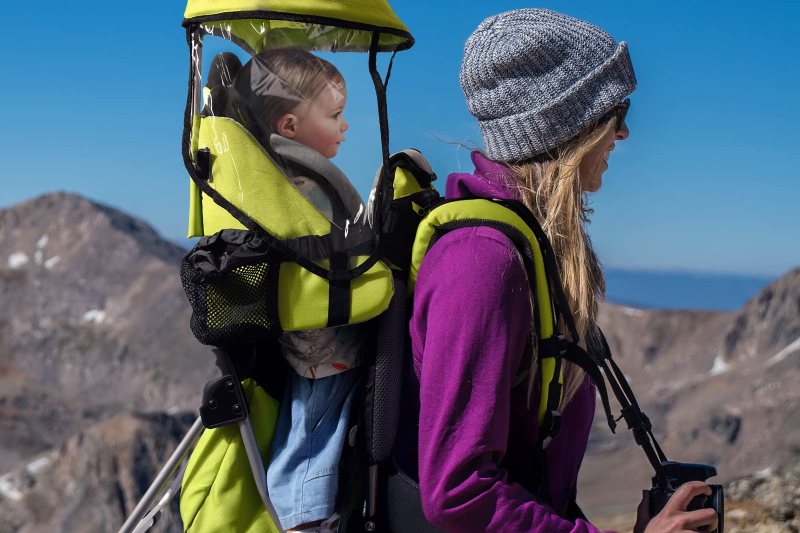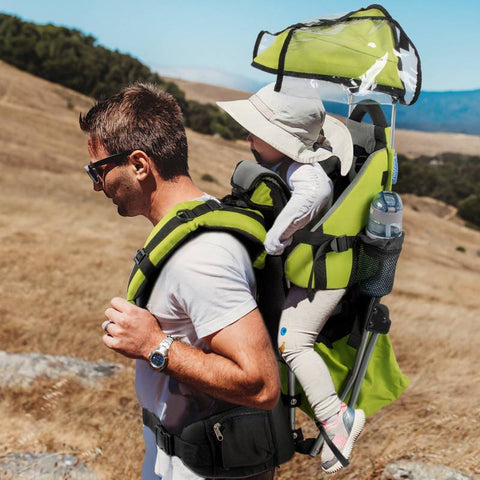
What Age Can You Put a Baby in a Hiking Baby Carrier?
If you're a keen hiker and plan on taking your baby with you for the ride, a baby carrier for hiking is essential for hauling your little one along the trail. It's most likely your baby will love being in the great outdoors, and this is an ideal way to introduce them to it.
Today in this Besrey blog post, we look at what age you can put a baby in a hiking baby carrier, as well as a guide for the safe use of a baby hiking carrier backpack. Read on to the end for the perfect option if you are planning on buying a baby backpack carrier.

What is a Hiking Baby Carrier?
A hiking carrier is a baby carrier worn like a backpack, except that it's attached to a sturdy metal frame with a 'cockpit' seat that your baby or toddler sits in. While owning such an item is an excellent idea if you're planning on taking a little one hiking with you, there are loads of scenarios in which a backpack carrier would come in handy. A baby backpack carrier is worth owning if you frequently go on day trips, picnics, or visits to the park.
Active parents will undoubtedly benefit from owning a baby backpack carrier. It's a very versatile kit, and babies love to sit in backpack carriers. They love sitting up high, allowing them to take in their surroundings and get a better view of the world, which often puts a smile on their face.
Before you use a hiking backpack carrier, read this buying guide and you will easily buy one of the best baby hiking carrier.
What is the Best Baby Hiking Backpack?
What Age Can You Put Your Baby in a Hiking Baby Carrier?
Typically, a baby should be a least 6 months old to sit in a hiking backpack carrier. Babies' spines must develop enough to support their neck and head without assistance. As for baby weight, backpack carriers are generally most suited to babies weighing 15-25kg (30-55lbs).
Three important things to consider are:
- Your baby exceeds the minimum weight specifications the manufacturer has set for that carrier
- Your baby can support their head and neck
- Your baby can sit upright unassisted
If your baby meets these requirements, then chances are they are excellent to sit in a baby hiking carrier. But there are other things to consider, which leads us to our next question: how long should a baby be in a hiking baby carrier?
How Long Should a Baby Be in a Hiking Baby Carrier?
While there is no determined maximum time for how long a baby can sit in a hiking baby carrier, there are several considerations you should be aware of. Ideally, a baby shouldn't be in a carrier for more than two hours at a time. It is likely, however, that if your baby isn't happy about something, they will certainly let you know!
You will need plenty of rest too, but as a general guide, take regular breaks when hiking with your baby and give them some time out of the carrier to let them move and stretch their limbs. When seated in the carrier, frequently check that your baby is sitting upright and not slumped forward. It is essential to prevent positional asphyxia when the baby is at risk of suffocation because they are in a position that restricts their breathing movement.
In addition, pay attention to the heat. Keep the sun off your baby's face, but do not cover their face with anything that might restrict airflow around them. And, of course, keep your baby hydrated.
In general, check your baby often for any signs they are unhappy, ensure they are seated upright when in the carrier and give them plenty of breaks outside the carrier.
Can I Wear My Baby All Day?
Some carriers, such as slings, and those intended for newborns or younger babies that support healthy positioning, can be worn for extended periods if both parent and baby are comfortable and happy. However, with hiking carriers for babies, they are not recommended to remain seated in the carrier for many hours. As explained above, two hours is a good guide for the maximum time, and whenever stopping for a break on your hike, it is a good idea to give your baby some time out of the carrier.
Guide to the Safe Use of Baby Carriers
Before wearing a baby hiking carrier, it is a good idea to become familiar with the backpack and its operation without your baby. Get used to wearing it and make the necessary adjustments to the straps. Read the manufacturer's user manual and heed all safety warnings.
Steps for Safely Putting Your Baby in the Carrier:
- Place the backpack carrier with the frame open on a flat, stable surface. It's recommended to place it on a table or elevated surface, as this will make it easier to lift it.
- Sit your baby or toddler in the cockpit seat and gently lift their legs to ensure they are correctly and firmly seated.
- Connect the 5-point safety harness and adjust straps as necessary. Ensure the straps firmly hold the child in place but are not restrictive.
- Next, adjust the foot stirrups to support the legs. The idea of the foot stirrups is that they raise the legs and prevent the thighs from chaffing on the edge of the seat. If the legs are dangling, this may cause discomfort to the baby over time.
- Ensure your baby is comfortably sitting upright and not slumped forward.
- Finally, with the baby secure and comfortable in the cockpit seat, place both arms through the shoulder straps, connect the waist clip and chest strap, and slowly lift the backpack carrier.
Conclusion
If you were a keen outdoor person pre-parenthood, then a hiking baby carrier is one thing that should be on your radar of baby items to own.





